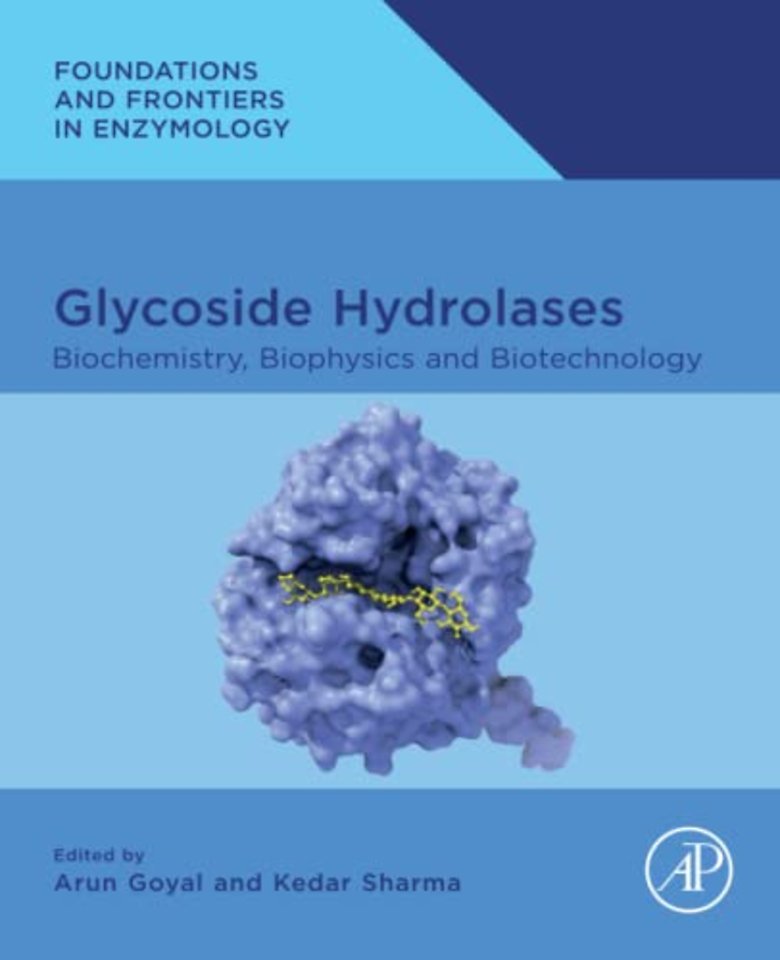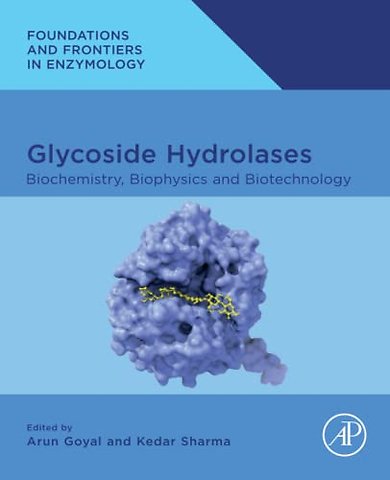<p>Contributors <br>About the Editors<br>Preface</p> <p>CHAPTER 1 Carbohydrates and Carbohydrate-Active enZymes (CAZyme): An overview<br>Parmeshwar Vitthal Gavande, Arun Goyal, and Carlos M.G.A. Fontes</p> <p>1.1 Introduction<br>1.1.1 Various carbohydrate polymers present in nature<br>1.1.2 Natural source of polysaccharides<br>1.1.3 Requirement for deconstruction of carbohydrates<br>1.1.4 Carbohydrate-active enzymes<br>1.1.5 Carbohydrate-active enzyme database (CAZy)<br>1.1.6 Multienzyme complexes of CAZyme: The cellulosome<br>1.1.7 Commercially available CAZyme libraries<br>1.2 Conclusion<br>References</p> <p>CHAPTER 2 Glycoside hydrolases: Mechanisms, specificities, and engineering<br>Antoni Planas</p> <p>2.1 Structures, functions, and classifications<br>2.2 Glycosidase mechanisms for hydrolysis of glycans and glycoconjugates<br>2.2.1 General mechanisms: Inverting vs. retaining<br>2.2.2 Retaining glycosidases with enzyme nucleophile: Ring distortion and covalent intermediate<br>2.2.3 Retaining glycosidases by substrate-assisted catalysis: Oxazoline/oxazolonium intermediate<br>2.2.4 Retaining glycosidases by neighboring-group participation through a 1,2-epoxide intermediate<br>2.2.5 Retaining glycosidases by an unusual NAD+-dependent mechanism<br>2.2.6 Inverting glycosidases<br>2.3 Protein engineering of glycosidases for improved and novel properties<br>2.3.1 Thermostability<br>2.3.2 Substrate specificity<br>2.4 Glycosidases acting in reverse for glycosynthesis: Transglycosidases and glycosynthases <br>2.4.1 Transglycosidases<br>2.4.2 Glycosynthases<br>2.5 Concluding remarks<br>References</p> <p>CHAPTER 3 Endo-β-1,4-glucanase<br>Parmeshwar Vitthal Gavande and Arun Goyal</p> <p>3.1 Introduction<br>3.1.1 Cellulase<br>3.1.2 Cellulase evolution and conservation in nature<br>3.1.3 Endo-β-1,4-glucanase<br>3.1.4 Exoglucanase<br>3.1.5 β-glucosidase<br>3.1.6 Cellulosome<br>3.2 Endoglucanases belong to various GH families<br>3.2.1 GH5 family<br>3.2.2 GH6 family<br>3.2.3 GH7 family<br>3.2.4 GH8 family<br>3.2.5 GH9 family<br>3.2.6 GH12 family<br>3.2.7 GH44 family<br>3.2.8 GH45 family<br>3.2.9 GH48 family<br>3.3 Synergism of endo-β-1,4-glucanase with exoglucanase and β-glucosidase<br>3.4 Endo-β-1,4-glucanase-producing microorganisms<br>3.4.1 Biochemical properties, kinetics, and catalytic efficiency of endoglucanases<br>3.5 Structure of endo-β-1,4-glucanases<br>3.5.1 Mechanism of cellulose hydrolysis in endoglucanases<br>3.6 Multifunctionality of endoglucanases<br>3.6.1 Broad substrate specificity of various endoglucanases<br>3.6.2 Significance of multifunctional endoglucanases<br>3.7 Processivity of endoglucanases<br>3.8 Applications of endoglucanases<br>3.9 Conclusion<br>Authors’ contribution<br>References</p> <p>CHAPTER 4 Cellobiohydrolases<br>Tulika Sinha, Kanika Sharma, and Syed Shams Yazdani</p> <p>4.1 Introduction<br>4.2 Structure and mode of action of cellobiohydrolases<br>4.2.1 The catalytic domain (CD)<br>4.2.2 The carbohydrate-binding module (CBM)<br>4.2.3 The linker<br>4.2.4 The dissociation mechanism of processive CBH1<br>4.3 Biochemical and biophysical properties of cellobiohydrolases<br>4.3.1 pH and temperature<br>4.3.2 Metal ions<br>4.3.3 Surfactants<br>4.4 Protein engineering and strain improvement for higher enzyme activity and productivity<br>4.4.1 Enhanced activity<br>4.4.2 Enhanced thermostability<br>4.4.3 Enhanced performance in nonconventional media<br>4.4.4 Engineering cellulase for pH stability<br>4.5 Industrial applications of CBH<br>4.5.1 Bioconversion<br>4.5.2 Pulp and paper industry<br>4.5.3 Food processing industry<br>4.5.4 Textile industry<br>4.5.5 Agriculture<br>4.5.6 Animal feed<br>4.5.7 Detergent industry<br>4.6 Conclusion and future perspective<br>References</p> <p>CHAPTER 5 β-Glucosidase: Structure, function and industrial applications<br>Sauratej Sengupta, Maithili Datta, and Supratim Datta</p> <p>5.1 Introduction<br>5.2 Classification <br>5.3 Structure<br>5.4 Reaction mechanism<br>5.4.1 Substrate recognition and specificity<br>5.4.2 Glycone and aglycone specificity<br>5.5 Function and distribution<br>5.6 Characteristics<br>5.6.1 Biophysical characteristics<br>5.6.2 Biochemical characteristics<br>5.6.3 Product inhibition and enhancement of activity in the presence of glucose <br>5.6.4 Substrate inhibition<br>5.7 Industrial applications<br>5.7.1 Biofuels<br>5.7.2 Food industry<br>5.7.3 Pharmaceutical industries<br>Acknowledgments<br>References</p> <p>CHAPTER 6 Endo-β-1,3-glucanase<br>Parmeshwar Vitthal Gavande and Arun Goyal</p> <p>6.1 Introduction<br>6.2 The role of endo-β-1,3-glucanase in nature<br>6.2.1 β-1,3-Glucan<br>6.2.2 Exo-β-1,3-glucanase<br>6.2.3 Endo-β-1,3-glucanase<br>6.2.4 Classification of endo-β-1,3-glucanases<br>6.3 Sources of endo-β-1,3-glucanase<br>6.4 Endo-β-1,3-glucanases of different families, their structure, and mechanism <br>6.4.1 The family GH5 <br>6.4.2 The family GH16 <br>6.4.3 The family GH17 <br>6.4.4 The family GH55 <br>6.4.5 The family GH64 <br>6.4.6 The family GH81<br>6.4.7 The family GH128, GH152, GH157, GH158<br>6.5 Applications of endo-β-1,3-glucanases<br>6.6 Conclusion<br>References<br>Further reading</p> <p>CHAPTER 7 Diversity of microbial endo-β-1,4-xylanases<br>Peter Biely, Katarı´na Sˇuchova´, and Vladimı´r Puchart</p> <p>7.1 Introduction<br>7.2 Chemical structure of plant xylans<br>7.3 Enzymes of xylan hydrolysis<br>7.4 Endoxylanases—Xylan depolymerizing enzymes<br>7.4.1 Molecular architecture of xylanases<br>7.4.2 Classification into glycoside hydrolase families<br>7.4.3 Mode of action and structure-function relationship<br>7.5 Synergism of endoxylanases with debranching xylanolytic enzymes <br>7.6 Application of xylanases<br>7.7 Conclusions and future prospects<br>References</p> <p>CHAPTER 8 β-D-Xylosidases: Structure-based substrate specificities and their applications<br>Satoshi Kaneko and Zui Fujimoto</p> <p>8.1 Introduction<br>8.2 Structures of β-xylosidases<br>8.2.1 GH3<br>8.2.2 GH39<br>8.2.3 GH43<br>8.2.4 GH52<br>8.2.5 GH120<br>8.2.6 Other families<br>8.3 Substrate specificities of the β-xylosidases<br>8.3.1 GH1 <br>8.3.2 GH2 <br>8.3.3 GH3 <br>8.3.4 GH5<br>8.3.5 GH10<br>8.3.6 GH11 <br>8.3.7 GH30 <br>8.3.8 GH39<br>8.3.9 GH43<br>8.3.10 GH51<br>8.3.11 GH52<br>8.3.12 GH54<br>8.3.13 GH116 <br>8.3.14 GH120<br>8.4 Applications of β-xylosidases<br>References</p> <p>CHAPTER 9 Arabinofuranosidases<br>Priyanka Pisalwar, Austin Fernandes, Devashish Tribhuvan, Saurav Gite, and Shadab Ahmed</p> <p>9.1 Introduction<br>9.2 Classification<br>9.2.1 Classification on the basis of substrate specificity and mechanism of action <br>9.2.2 Classification on the basis of amino acid sequencing and structural similarity<br>9.3 Structural and functional characteristics of arabinofuranosidases<br>9.3.1 Effect of metal ions<br>9.3.2 Carbohydrate-binding modules (CBM) associated with arabinofuranosidases <br>9.4 Substrate specificity and biochemical properties of arabinofuranosidases<br>9.4.1 Substrate specificity<br>9.4.2 Physical and chemical properties<br>9.5 Industrial applications of arabinofuranosidase<br>9.5.1 Biofuel and biochemical industry<br>9.5.2 Food and animal feed industry <br>9.5.3 Beverage industry<br>9.5.4 Paper and pulp industry<br>9.5.5 Probiotic and pharmaceutical industry<br>9.6 Future trends and scope of arabinofuranosidases<br>9.6.1 Protein engineering<br>9.6.2 Development of new modular enzymes with enhanced substrate degradation potential<br>9.7 Conclusions<br>References</p> <p>CHAPTER 10 Glycoside hydrolase family 16—Xyloglucan:xyloglucosyl transferases and their roles in plant cell wall structure and mechanics <br>Barbora Stratilova´, Stanislav Kozmon, Eva Stratilova´, and Maria Hrmova</p> <p>10.1 Plant cell walls are protective multicomposite hydrogels<br>10.1.1 Plant cell wall composition and function<br>10.1.2 Plant cell wall structure and organization <br>10.2 Plant xyloglucan:xyloglucosyl transferases<br>10.2.1 Nomenclature and classification<br>10.2.2 Catalytic mechanism<br>10.2.3 Structural properties<br>10.2.4 Enzyme activity methods<br>10.2.5 Reactions with xyloglucan-derived and other substrates<br>10.2.6 Genetics approaches to the XTH gene function<br>10.3 The function of XTH enzymes in plant cell walls<br>10.3.1 Plant cell wall dynamics<br>10.3.2 Roles of XTH enzymes in cell wall restructuring<br>10.4 Conclusions and future directions<br>Author contributions<br>Funding<br>Conflict of interest<br>References</p> <p>CHAPTER 11 Endo-arabinase: Source and application<br>Dixita Chettri and Anil Kumar Verma</p> <p>11.1 Introduction<br>11.2 Hemicellulose structure and hydrolysis of arabinans<br>11.3 Source and biochemical characteristics<br>11.4 Structure and mechanism of action<br>11.5 Application of arabinase<br>11.6 Safety assessment<br>11.7 Conclusion and future prospects<br>Acknowledgment<br>Conflict of interest<br>References</p> <p>CHAPTER 12 Overview of structure-function relationships of glucuronidases<br>Samar Ballabha Mohapatra and Narayanan Manoj</p> <p>12.1 Introduction<br>12.2 Xylanolytic α-glucuronidases<br>12.2.1 GH67 α-glucuronidases<br>12.2.2 GH115 α-glucuronidases<br>12.3 Non-xylanolytic GH4 α-glucuronidase<br>12.3.1 Active site architecture and the substrate specificity of GH4 TmAgu4B <br>12.3.2 Mechanism of hydrolysis by GH4 AguA<br>12.4 β-Glucuronidases<br>12.4.1 GH1 β-glucuronidase<br>12.4.2 GH2 β-glucuronidases<br>12.4.3 GH30 β-glucuronidase<br>12.4.4 GH79 β-glucuronidases<br>12.4.5 GH154 β-glucuronidase<br>12.4.6 GH169 β-glucuronidase<br>12.5 Perspectives on the development of applications of glucuronidases<br>12.5.1 Xylanolytic α-glucuronidases<br>12.5.2 Inhibitors of β-glucuronidases<br>Credit<br>References</p> <p>CHAPTER 13 Mannanases and other mannan-degrading enzymes<br>Caio Cesar de Mello Capetti, Andrei Nicoli Gebieluca Dabul, Vanessa de Oliveira Arnoldi Pellegrini, and Igor Polikarpov</p> <p>13.1 Mannan structure<br>13.2 Enzymes involved in the mannan degradation<br>13.2.1 β-mannanases<br>13.2.2 Other enzymes important for mannan degradation<br>13.3 Production of β-mannanases<br>13.4 Industrial applications of β-mannanases<br>13.4.1 Oil drilling<br>13.4.2 Biofuel production<br>13.4.3 Production of manno-oligosaccharides<br>13.4.4 Paper and pulp production<br>13.4.5 Textile industry<br>13.4.6 Detergents<br>13.4.7 Pharmaceutical and food industry<br>13.5 Concluding remarks<br>References</p> <p>CHAPTER 14 Structure, function, and protein engineering of GH53 β-1,4-galactanases<br>Sebastian J. Muderspach, Kenneth Jensen, Kristian B.R.M. Krogh, and Leila Lo Leggio</p> <p>14.1 Introduction, classification, and structure overview of β-1,4-galactanases<br>14.2 Biological functions and diversity<br>14.2.1 Galactans in the plant cell walls<br>14.2.2 Degradation of plant cell wall galactans in plant pathogens via GH53 enzymes <br>14.2.3 Characterized GH53 galactanases from human gut microbiome<br>14.2.4 Plant cell wall remodeling for mobilization of energy resources or fruit ripening<br>14.2.5 GH53 galactanases from extremophiles<br>14.3 Related enzyme activities<br>14.3.1 Other microbial endo-galactanases<br>14.3.2 β-galactosidases and exo-β-1,4-galactanases<br>14.3.3 α-L-arabinofuranosidase and endo-1,5-α-L-arabinanase<br>14.4 GH53-associated modules and domains<br>14.4.1 Association of GH53 with carbohydrate-binding modules<br>14.4.2 Association of GH53 with other domains<br>14.5 Biotechnological applications<br>14.5.1 GH53 galactanases in enzymatic degradation of biomass<br>14.5.2 Prebiotic galactooligosaccharide production<br>14.5.3 Other industrial uses<br>14.6 Structure-function studies<br>14.6.1 Conformation of substrate in a computationally derived BlGal-galactononaose complex<br>14.6.2 Substrate-binding sites in GH53 galactanase crystal structures and their implication on product profile<br>14.6.3 Structural features inducing thermostability in GH53 galactanases<br>14.6.4 Prediction of structural features from sequence alignments and AlphaFold models <br>14.7 Protein engineering<br>14.7.1 Modulating thermostability and pH optimum<br>14.7.2 Changing the product profile<br>14.8 Conclusions and future directions<br>References</p> <p>CHAPTER 15 Structural and functional insights and applications of β galactosidase<br>Azra Shafi and Qayyum Husain</p> <p>15.1 β Galactosidase<br>15.2 Glycoside hydrolase families<br>15.3 Sources of β-galactosidases<br>15.3.1 Bacterial β-Gals<br>15.3.2 β-Gals from filamentous fungi<br>15.3.3 β-Gals from yeasts<br>15.3.4 β-Gals from plants<br>15.3.5 β-Gals from animals<br>15.3.6 Recombinant β-Gals<br>15.4 Lactose intolerance<br>15.5 Structural characterization of β-Gal<br>15.5.1 The active site<br>15.5.2 Metal binding sites<br>15.6 Functional characterization of β-Gal<br>15.6.1 Mode of action and reaction mechanism<br>15.6.2 Hydrolysis and transgalactosylation activities of β-Gal<br>15.7 Applications of β-Gal<br>15.7.1 Lactose-hydrolyzed milks<br>15.7.2 β-Gal supplements<br>15.7.3 Treatment of industry effluents<br>15.7.4 Synthesis of GOS<br>15.7.5 Reactors and biosensors<br>15.8 Conclusion<br>References</p> <p>CHAPTER 16 α-L-Rhamnosidases: Structures, substrate specificities, and their applications<br>Satoshi Kaneko and Zui Fujimoto</p> <p>16.1 Introduction<br>16.2 Structure of α-L-rhamnosidases<br>16.2.1 GH78<br>16.2.2 GH106 <br>16.3 Substrate specificities of α-L-rhamnosidases<br>16.3.1 GH78 <br>16.3.2 GH106 <br>16.3.3 Unknown family<br>16.4 Applications of α-L-rhamnosidases<br>References</p> <p>CHAPTER 17 Diversity and biotechnological applications of microbial glucoamylases<br>Sanjeev Kumar, Priyakshi Nath, Arindam Bhattacharyya, Suman Mazumdar, Rudrarup Bhattacharjee, and T. Satyanarayana</p> <p>17.1 Introduction<br>17.2 Production of glucoamylase: Microbes, substrate, nutrients, and fermentation system<br>17.3 Thermophilic and mesophilic fungal glucoamylases<br>17.4 Production of native glucoamylases<br>17.5 Recombinant glucoamylases<br>17.6 Multiple molecular forms of glucoamylases<br>17.7 Structural characteristics of glucoamylases<br>17.8 Biotechnological applications of glucoamylase<br>17.9 Role of glucoamylase in starch conversion to sugar syrup<br>17.10 Role of glucoamylase in HFCS<br>17.11 Role of glucoamylase in the brewing and baking industry<br>17.12 Conclusion<br>References</p> <p>Index</p>

